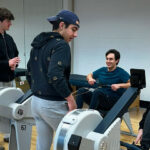





The facility is comprised of outdoor exhibits in a park setting of 8 Courts, containing a total 52 exhibits. The Courts are organized into the subjects of Water, Energy, Waves, Forces, Vision, Sound, Motion, and Biology.
 Court of Water
Court of WaterWater is a fascinating medium for observing natural phenomena. Why do some objects float while others sink? What do whirlpools and tornadoes have in common? If you spin a body of water, what shape does it take? What role does water play as an alternative energy source? These and other questions will be explored through the exhibits of the Court of Water.
 Court of Force
Court of ForceEvery time we push on the universe (sit in a chair, pull on a rope, fall down), the whole universe pushes back. Force (a push or a pull) can cause an object to move, stop moving, or change direction. When you write with a pen you exert a force. When you pedal a bike, blow your nose, turn on a faucet, chew gum, or swim in a pool, you are exerting forces on other objects. The exhibits found in the Court of Forces demonstrate the concepts of inertia, gravity, centripetal force, friction, action/reaction, and collisions.
 Court of Sound
Court of SoundThe Court of Sound encourages participants to explore the nature of sound: how it is generated, what it is made of, how it travels. The exhibits demonstrate the wave nature of sound, that moving air can make sound, that a whisper can be heard over vast distances, that sound generation takes time, and illustrate the changing pitch of moving objects. The Court of Sound also encourages participants to explore the sounds produced by natural objects that resonate when struck.
 Court of Motion
Court of MotionMotion is the change in position of an object—but what forces can cause an object to move? What makes an object stop moving? Can objects move on their own? How is motion made easier? How is energy transferred from one object to another? Is motion predictable?
The exhibits in the Court of Motion will answer these questions, each of which is designed to arouse curiosity and to underscore basic physical laws. Some exhibits will demonstrate phenomena whose principles have been known since antiquity, while others will leave participants scratching their heads in awe.
 Court of Waves
Court of WavesThere are waves all around us — ocean waves, sound waves, light waves, and even waves of heat — the list goes on! But just what is a wave? A wave is a transfer of energy from one point to another. Most waves require a medium or material, to travel through — the exception is electromagnetic waves, or light, which can travel through a vacuum. Sound waves, for instance, typically travel through air—without air, there is no sound.
Waves can be described by their speed, frequency, wavelength, and amplitude (height). The Court of Waves examines wave phenomena, including those of light, sound and water, as well as the use of waves to transfer information.
 Court of Vision
Court of VisionWhat is an optical illusion? Why do our eyes deceive us at times? To an ordinary observer, the sun appears to be rotating around the earth, yet the opposite is true. Sometimes the moon appears to be a deep yellow or red, other times it appears white, but scientists know that the moon does not actually change color. Our senses, though, can be quite convincing.
The exhibits in the Court of Vision will persuade you that what you see is not necessarily what really exists. Two people can look at the same object at the same time and see two different things.
 Court of Biology
Court of BiologyWhat are we made of? How do we grow? Why do we breathe? Why do insects have six legs, animals four, and snakes none? Do fish breathe and how? How is fur different from feathers? Do animals see in color? Do insects hear? The questions are endless.
The Court of Biology investigates these and other phenomena of life. Participants are encouraged to “see” through all of our senses, explore, and seek answers to many questions in the biological realms. These adventures may lead to further research and study in agriculture, botany, medicine, and other biology related fields.
 Court of Energy
Court of EnergyThe Court of Energy exhibits are designed to enhance the participant’s awareness of the need for balance in nature, and how we can use renewable energy to do work. Of special interest are exhibits showcasing wind and solar energy.





